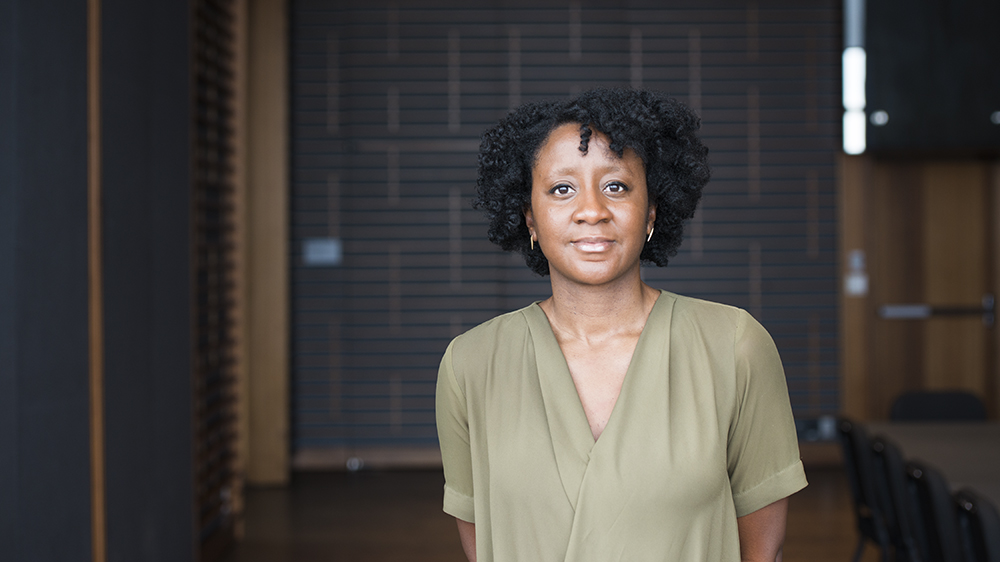Architectural Record Ι March 19, 2018
Yesomi Umolu is interested in applying her multi-disciplinary expertise (with stops in architecture school, practice, and the elite contemporary art curatorial class) and globe-trotting personal and professional background to a biennial that speaks to an equally wide range of public audiences.
“The biennial is for and of the city of Chicago, as well as being a big international platform, so our ability to translate ideas to a broad range of publics is super important,” she says.
Recently announced as the artistic director of the 2019 Chicago Architecture Biennial, Umolu is the Exhibitions Curator at the Tod Williams and Billie Tsien -designed Reva and David Logan Center for the Arts at the University of Chicago, where several of her exhibitions have displayed a distinct architectural bent. She earned a master’s degree in architectural design from the University of Edinburgh and another master’s in art curation from the Royal College of Art in London, and practiced as an architect with Grimshaw and Haworth Tompkins for two years.
The transition from the first to the second biennial, hosted at the ornate Beaux-Arts Chicago Cultural Center, saw a narrowing of thematic focus. But Umolu is making plans for a biennial that, no matter the theme, is expansive across the breadth of Chicago’s rich architectural traditions, and the world stage this biennial is growing into. As she says, it will be “a biennial that has reach beyond the Cultural Center.”
What kind of expertise are you looking for as you round out your curatorial team?
I’m thinking about individuals that are a little bit more enmeshed in the architectural scene than I am right now. Secondly, individuals that have experience with large-scale exhibition making, and have a strong understanding as to the role we play in [terms] of addressing different publics.
How much pressure do you feel to use the biennial to react to current events and news? It seems like it might be hard to resist, given the frenzied tenor of our times.
I feel a commitment to contemporary production. I’m a contemporary art curator. There’s a reason why I decided to follow that avenue instead of being an art historian. I’m interested in the artist’s voice. My role is not to speak through them, but to be an interlocutor and to provide the best type of framework in which they can explore new ideas and be presented to a broad public. Working with contemporary artists suggests that they’re going to be interested in the contemporary. And that might take different forms.
The last biennial largely operated across two separate tracks: First, there’s the speculative and experimental international gala at the Chicago Cultural Center. And second, the satellite exhibits focused on Chicago-centric, populist expressions of the built environment. Do you have interest in cross-pollinating these tracks?
What I’m interested in and excited about is the city as a potential platform for the entire biennial. This is not just a curatorial project; it’s a civic project as well. There’s a lot of investment across the city, from the Department of Cultural Affairs and Special Events, to people in different neighborhoods who feel invested in this as an opportunity to celebrate the city’s architectural heritage, but also as an opportunity to showcase the biennial as a testing ground for emerging ideas
You grew up, in part, in Lagos, Nigeria, a place that has garnered significant interest from Western and developed-world architects and planners, who have come to respect (and sometimes idealize) its low-impact, vernacular functionality. Certainly, that experience hasn’t completely defined your curatorial point of view, but I’m curious if exposure to developing world urbanism has had any influence on your eye for architecture?
I see myself as a global citizen for better or worse, and that will no doubt define what I do.
I was born and brought up in Lagos. I moved to London when I was 10. I’ve spent a lot of my life in Europe and the United States, and I have the good fortune as a curator to be able to travel all over the world and experience different types of urbanisms.
I couldn’t say that anything that I do owes particularly to the fact that I was born in Nigeria. What I do owes to the fact that I see myself as a global citizen, and I understand that being in Chicago and working here is about being connected to different global centers.
